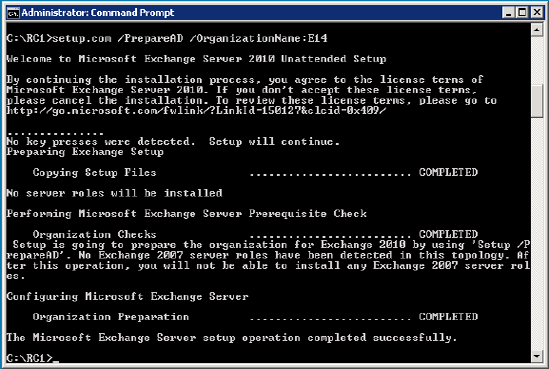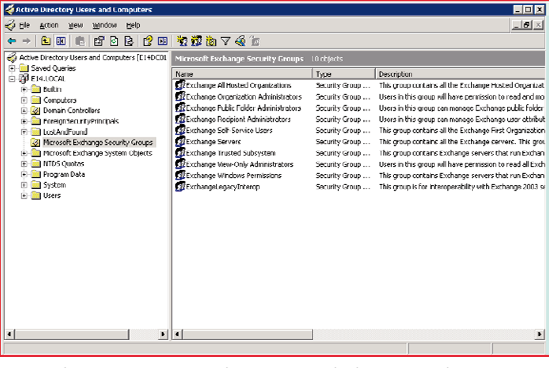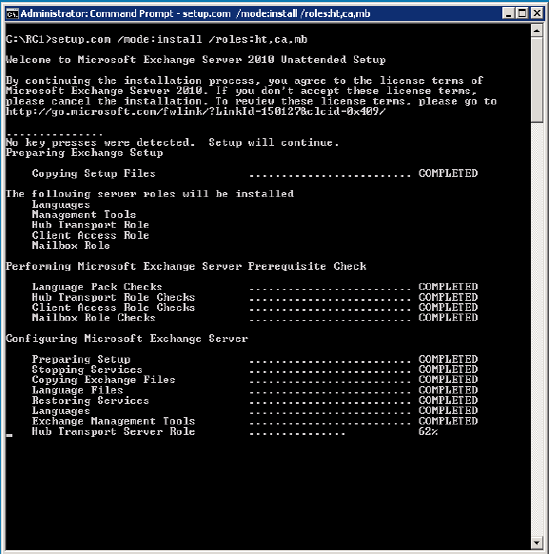It is also possible to install Exchange Server 2010
fully unattended. This may be useful when installing multiple servers,
since unattended setup is actually less
prone to errors. This process assumes that all the prerequisite
software has been installed, including Internet Information Server and
the LDIFDE program (HTTP://TINYURL.COM/LDIFDE) to prepare the Schema.
1 PrepareSchema
The first step in an unattended
setup is to prepare the schema. This basically means upgrading the
schema to an Exchange Server 2010 level. Several Exchange-related
objects and attributes are added to the Active Directory Schema, which
can take a considerable amount of time. You'll need to be patient,
again.
To prepare the Schema, log on to
the server as an administrator who is a member of both the Schema Admins
and Enterprise Admins Security Groups. Open a command prompt, navigate
to the Exchange Server 2010 installation media and type the following
command:

The command line setup
program will start and upgrade the Active Directory schema to an
Exchange Server 2010 level. If you have multiple Domain Controllers,
wait until the Schema changes have been replicated to all Domain
Controllers in the forest before continuing with the next step.
2 PrepareAD
After preparing the Schema, Active Directory now has to be prepared for Exchange Server 2010 because,
the Exchange Server 2010 organization is installed in the Configuration
Partition of Active Directory. This is why the account used for the
installation needs to be a member of the Enterprise Admins Security
Group (Domain Administrators cannot write in the Configuration
Partition).
Log on to the server, open a command prompt and navigate to the Exchange Server 2010 installation media, and type this command:

The Active Directory
Configuration Partition will now be prepared for Exchange Server 2010
using the previously-mentioned "E14" Organization name.

Please
note the warning during setup; if you create an Exchange Server 2010
organization, you are not able to add any Exchange Server 2007 server
roles to it!
If you want to check the creation of the Exchange Server 2010 organization you can use ADSIEdit (see Figure 8)
and navigate to the Configuration container. Open CN=Configuration >
CN=Services > CN=Microsoft Exchange. Right here, a new entry CN=E14
holding the Exchange Server 2010 configuration should be created.
If you have multiple
Domain Controllers, wait until the Schema changes have been replicated
to all Domain Controllers in the forest before continuing with the next step.
3 PrepareDomain
The last step in preparing the Active Directory environment is to prepare the domain that is going to host Exchange Server 2010.
Log on to the server using an
administrator account, open a command prompt and navigate to the
Exchange Server 2010 installation media. Type the following command:


The current domain will now be
prepared for the introduction of Exchange Server 2010. If you want to
prepare all domains in the forest for Exchange Server 2010, you can also
use the /PrepareAllDomains switch.
During the preparation of
the domain, a container is created in the root of the domain called
"Microsoft Exchange Security Groups." This container holds the following
Security Groups:
Exchange all hosted organizations
Exchange organization administrators
Exchange Public Folder administrators
Exchange Recipient Administrators
Exchange Self-Service users
Exchange Servers
Exchange Trusted Subsystem
Exchange view-only administrators.
Exchange Windows permissions.
ExchangeLegacyInterop.

When the preparation of the
domain (or indeed domains) is finished, just make sure you wait until
replication to all the Domain Controllers is finished.
4 Install Server roles
The very last step is to
install the actual server roles. This can be done using the setup.com
program with the /mode and /roles switches. The /mode switch is used to
select the "install" option, the /roles switch is used to select which
server roles are installed.
For an unattended
typical server setup, log on to the server and open a command prompt.
Navigate to the Exchange Server 2010 installation media (one last time)
and enter the following command:

The Exchange Server
2010 Hub Transport Server, Client Access Server and Mailbox Server role
will now be installed in the default location, which is C:\Program
Files\Microsoft\Exchange\v14.
When entered, the following will be shown on the screen:
